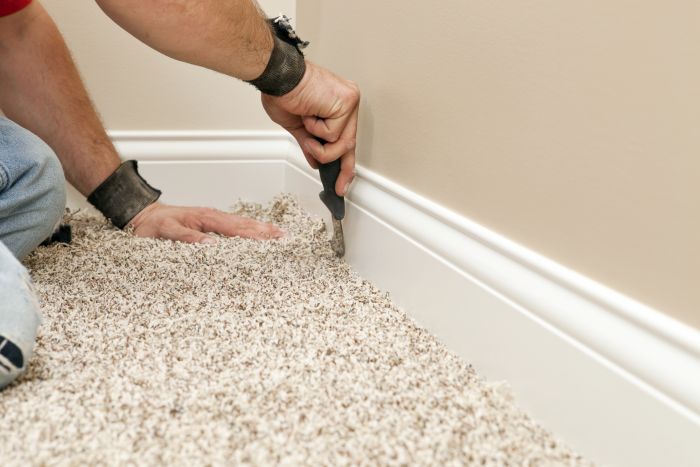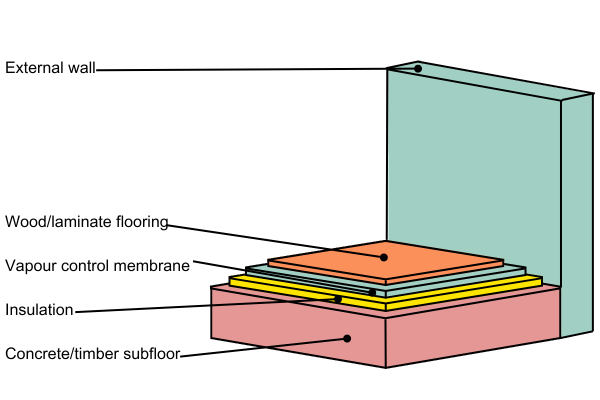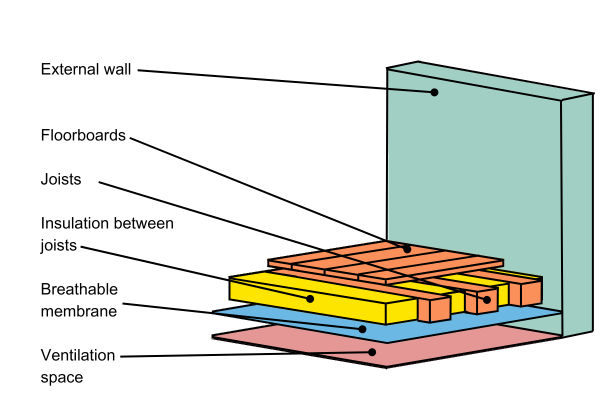Floor and underfloor insulation
Around 10% of our home’s warmth disappears beneath our feet. Underfloor insulation can help keep your home warmer whilst lowering your energy bills.

If your home has a ground floor, or if you’re on an upper floor above an unheated space, then underfloor insulation will help reduce heat loss.
Keeping the heat in is good for your wallet too. Floor insulation can save you around £60 a year on your energy bills.
Read on to find out which type of floor insulation is right for your home. You can also check out our draught proofing guide for some easy, cost-effective ways to save money and warmth without lifting a single floorboard.
What is underfloor insulation?
Underfloor insulation helps to stop heat escaping through the floor and into the ground.
If there’s a cavity (gap) between your floor and the ground (such as suspended timber floors in older homes and properties), then you would put insulation into this cavity.
If there is no gap between the floor and the ground (as with a solid floor) you would add insulation either above or below the concrete or screed layer. We’ll explain both these processes in more detail below.
How does underfloor insulation work?
As with all kinds of insulation, you’re adding a layer to prevent heat loss from inside your home. What that layer is made of, and where exactly you install it, depends on the type of floor you have.
Floor types
The most common floor types are:
- Suspended timber
- Solid
Older homes are more likely to have suspended timber floors, whilst newer homes are more likely to have solid floors.
What is a suspended timber floor?
Also called a suspended wooden floor, with a suspended timber floor, floorboards are fitted over wooden joists. You can picture the joists like the slats on a wooden bedframe. The floorboards sit on top of the frame, just like your mattress sits on top of the slats. Like your mattress, the floorboards are suspended above an empty space.
What is a solid floor?
A solid floor is usually made up of several layers. You can think of it like a solid bedframe, with no slats and no legs. There’s no empty space between the bedframe and the ground. The mattress is like the top layer of flooring, whether that’s carpet, tiles or laminate.
How do I know which type of floor I have?
You may be able to find out what type of floor you have from your home’s Energy Performance Certificate. If you don’t have a paper copy, check the Scottish EPC register website for an online version.
If you don’t have an EPC, try the following methods:
The best way to tell if you have a suspended timber floor is to have look at it from underneath. You can do this if you have a basement or cellar, or some other way of safely accessing the space below your home. If it’s a suspended timber floor, you’ll be able to see the joists (beams of wood) supporting the floorboards.
If there’s no safe way to check from below, you’ll need to look under the carpet and underlay. If you find floorboards rather than solid concrete, you have a suspended timber floor.
Suspended timber floors need to be ventilated. This means there should be air bricks or ventilation bricks (bricks with a pattern of holes) leading to the outside of your home. If you check the outside wall and there are air bricks below the level of the floor, it’s very likely you have a suspended timber floor. If there are no air bricks, it’s likely you have a solid floor.
A slightly more energetic way of working out your floor type is to jump up and down on it. If there’s a slight give and your furniture vibrates, you probably have a suspended timber floor. If there’s no give to the floor and little reverb from the furniture, you’ve probably got a solid floor.

How do I insulate a solid floor?
Underfloor insulation boards can be added either above or below the concrete or screed layer.
Fitting the insulation on top of the concrete would slightly raise the level of floor. This means you may need to refit skirting boards and carry out some electrical work as well. You would also need to trim the bottom of your doors.
Fitting the insulation under a concrete floor slab or screed would involve replacing the entire floor. Floor insulation boards would be fitted on top of a damp proof membrane. This would be quite a big project, so you might want to combine it with installing underfloor heating.
It’s important to note that if you are replacing your floor, building regulations require that the new floor is insulated.

How do I insulate a suspended timber floor?
For insulating wooden floors, the easiest method is to insulate from below. If this isn’t possible, you’ll need to insulate from above. If you’re handy at DIY, you can save money by doing the timber floor insulation work yourself.
Both methods involve putting underfloor insulation between the joists (wooden beams). You can do this using mineral wool or floor insulation boards.
If you’re insulating from below, then you would gain access via a cellar, basement, or hatch.
If you’re insulating from above, then you would need to take up the floorboards to get under the floor.
It’s sometimes possible to insulate from below even if there’s limited access. A less disruptive alternative to taking up the floorboards is to use an insulation robot. Companies such as Q-bot send a remote-controlled robot under the floor to spray foam insulation between the joists. The robot only needs a small access hatch to be cut in the floorboards. This avoids pulling up multiple boards so that a human can fit down into the crawl space.
Underfloor insulation grant
Homeowners in Scotland can get grant funding of up to £1,500 for insulation through the Home Energy Scotland Grant. An extra £500 is available as an interest free loan.
To apply for the grant, simply call Home Energy Scotland for free on 0808 808 2282. Their advisors will be able to help you through the process. You can also contact Home Energy Scotland through their online form.
Register your interest in EcoCosi from Changeworks
Find out more about how our home retrofit service can help make your home warmer and more comfortable, as well as lower your energy bills.

Changeworks delivers Home Energy Scotland in the south east and Highlands and Islands on behalf of the Scottish Government and Energy Saving Trust.
As well as providing free, impartial expert advice to thousands of people every month to help them to keep warm in their homes for less, they identify funding opportunities for households seeking to install energy efficiency measures.
For more information, give Home Energy Scotland a call on 0808 808 2282 or email and the team will be happy to help you.
Useful pages
Is this page useful?